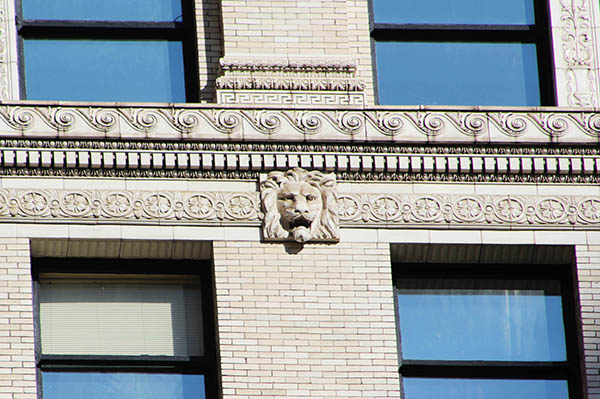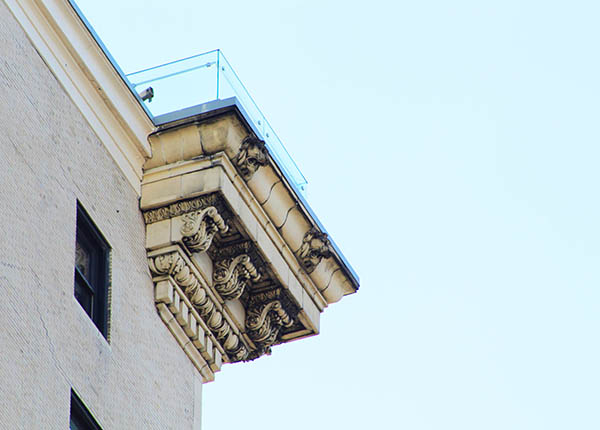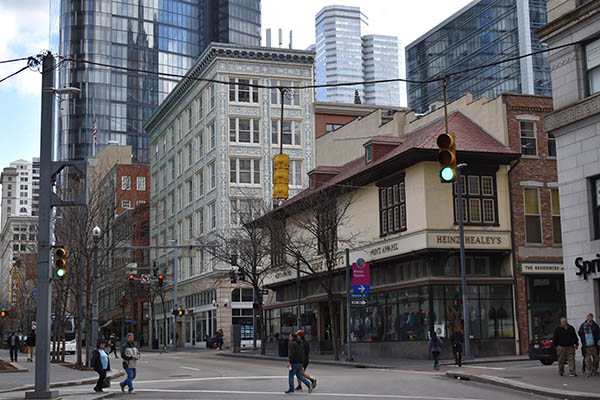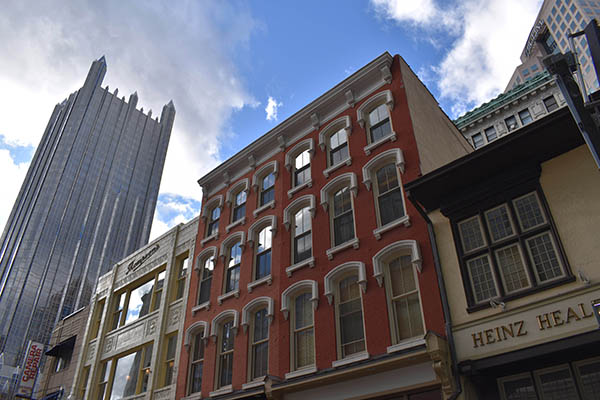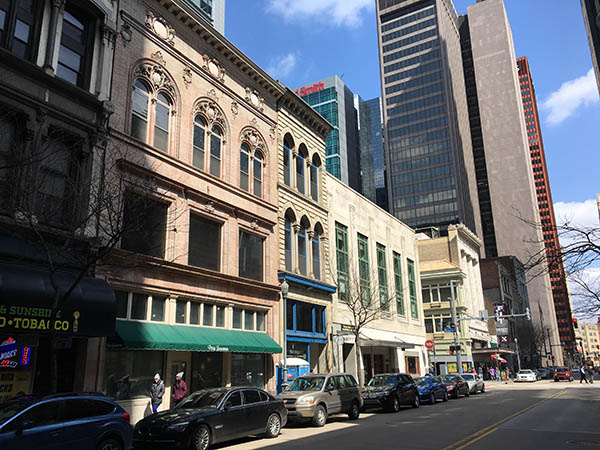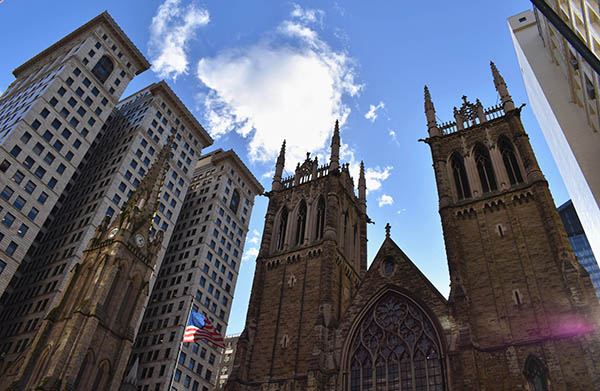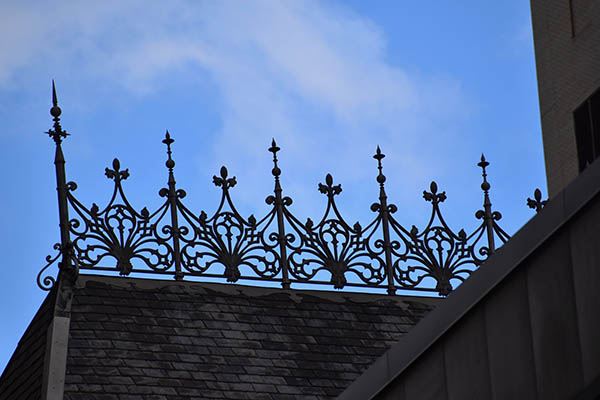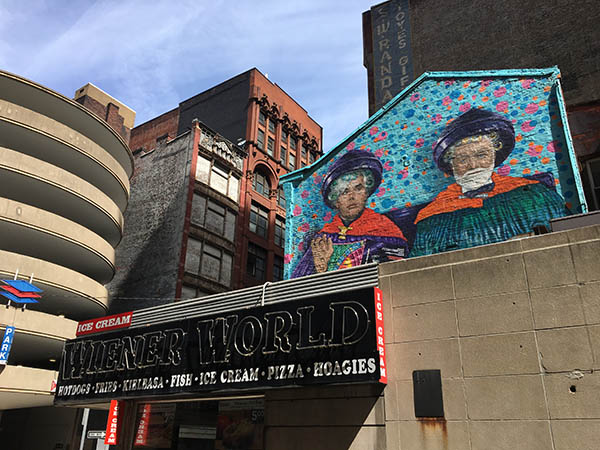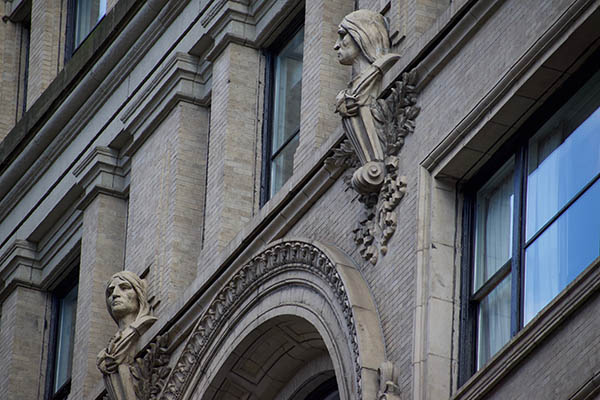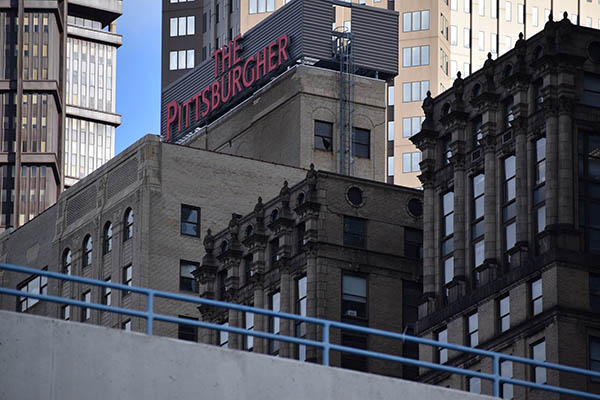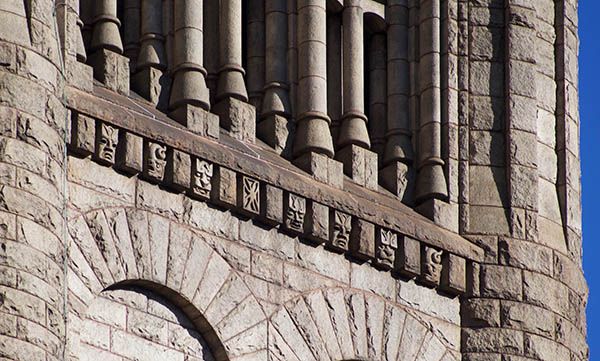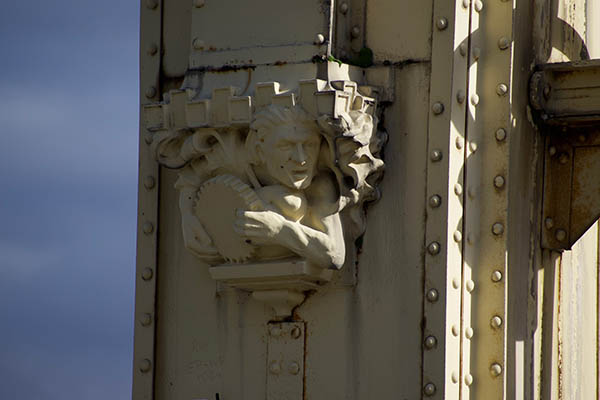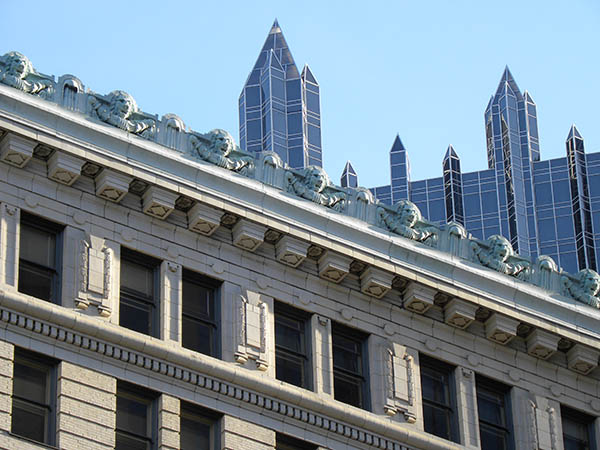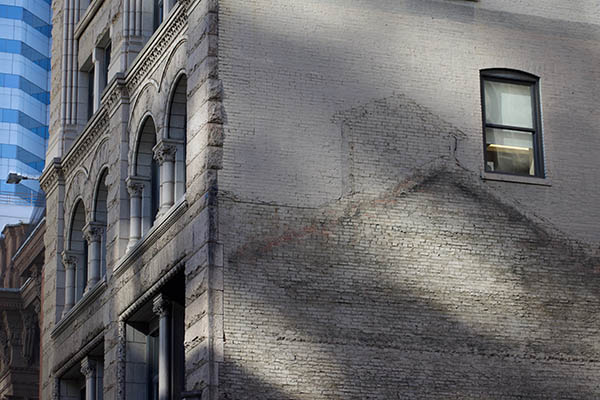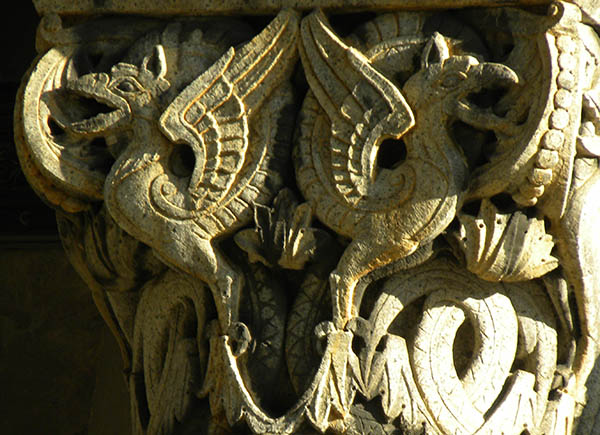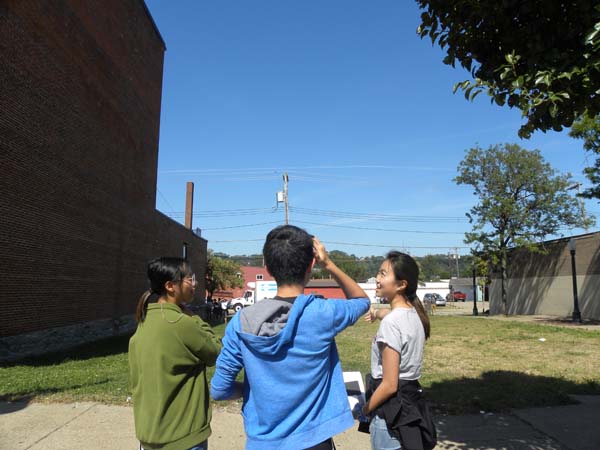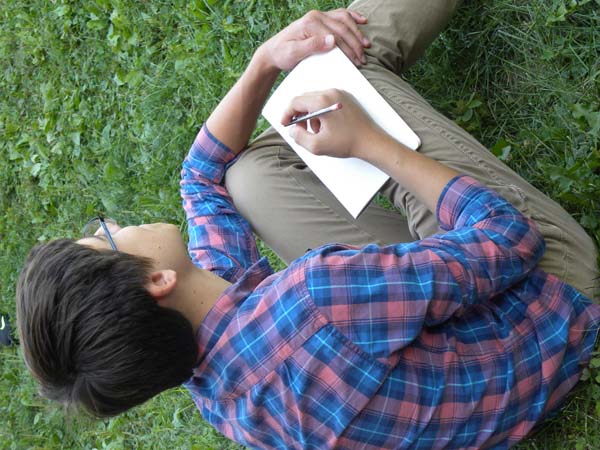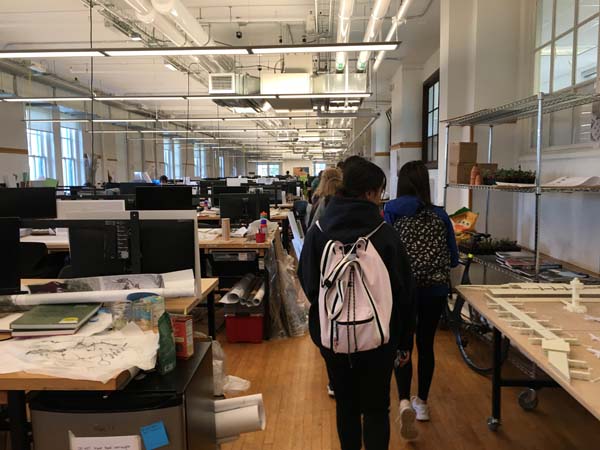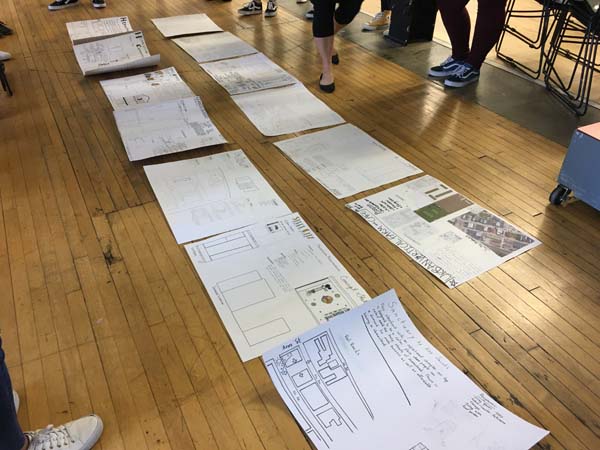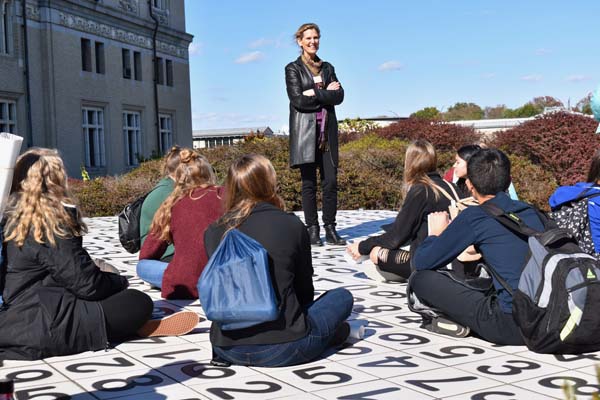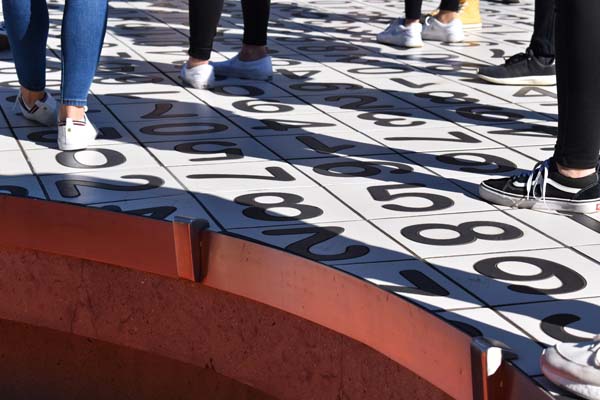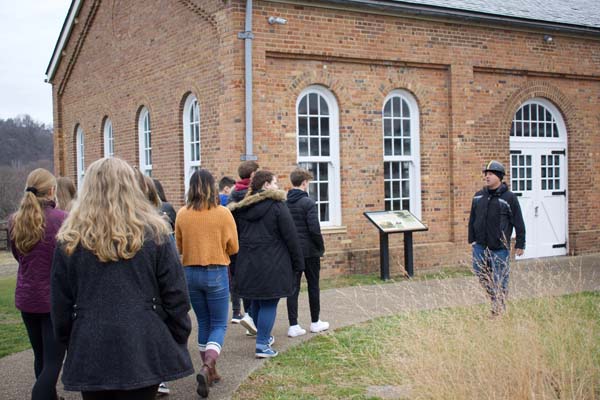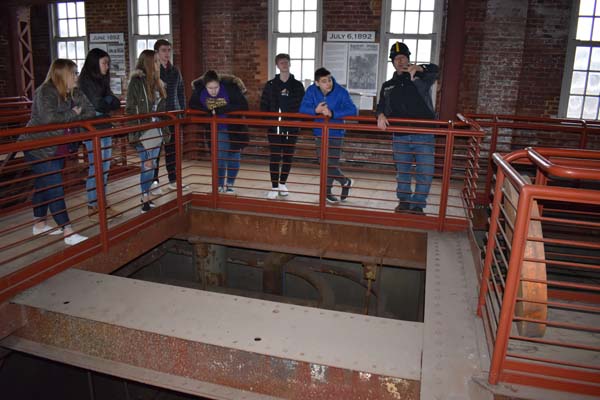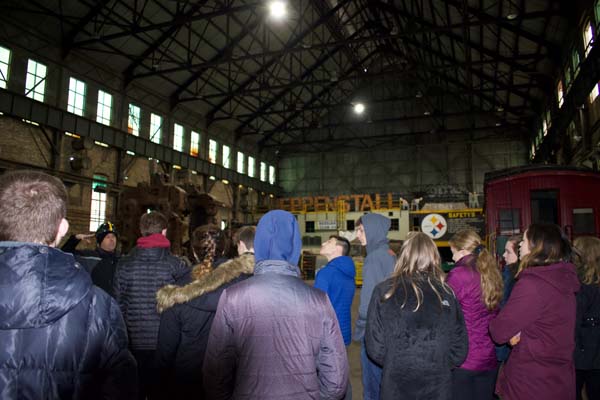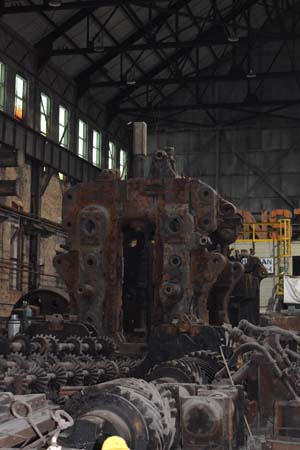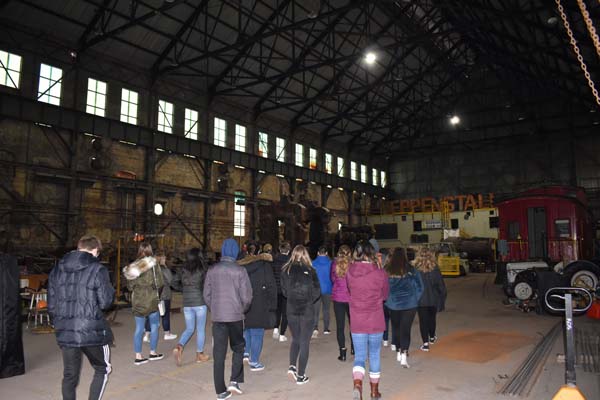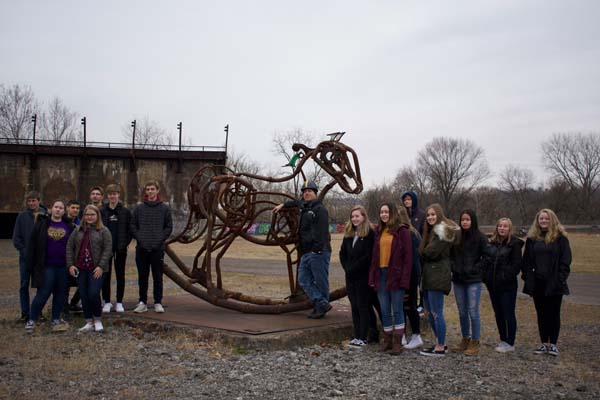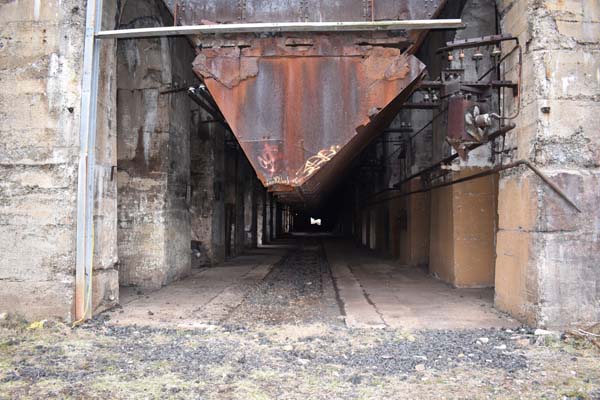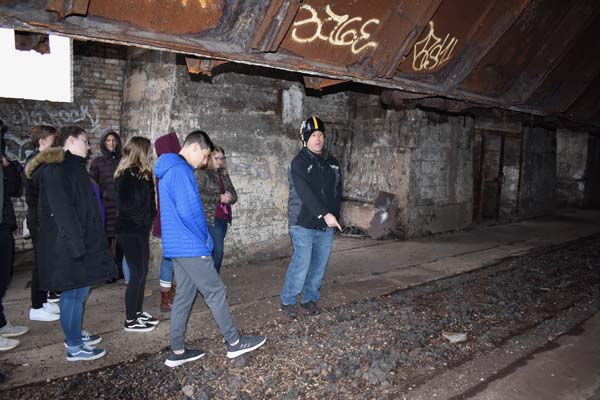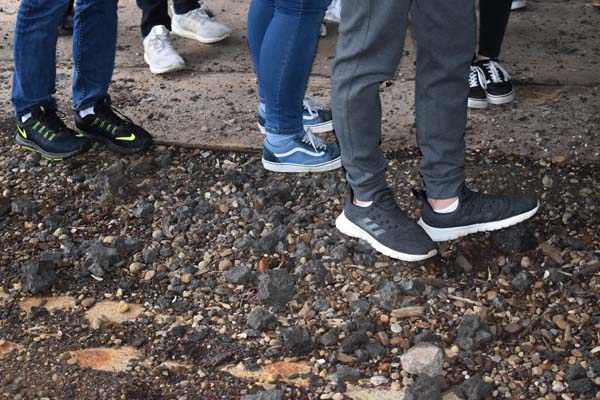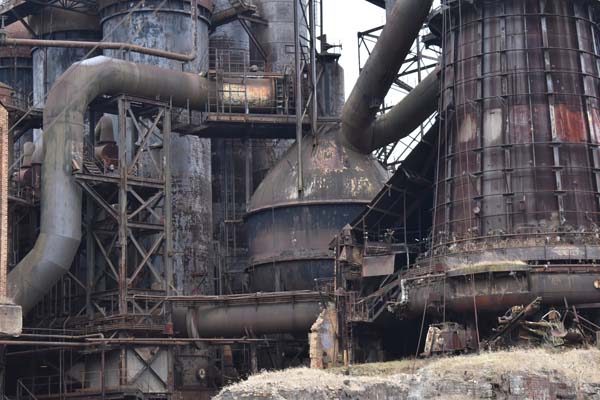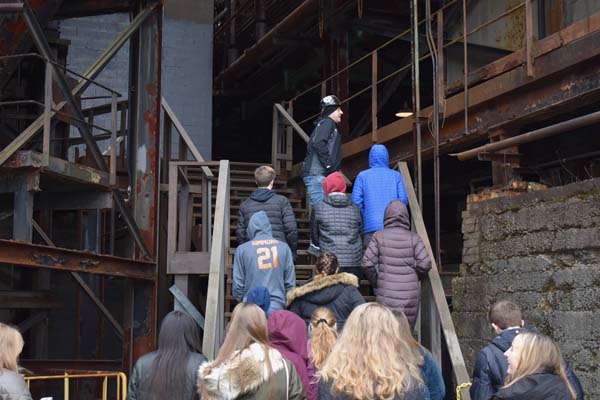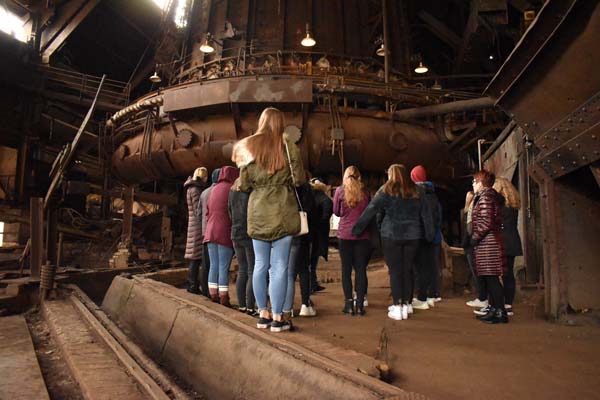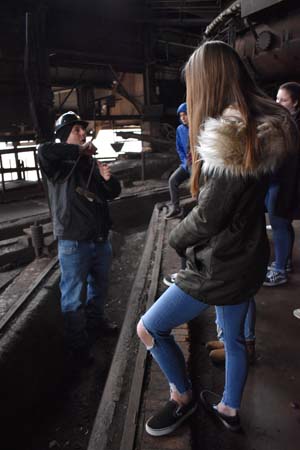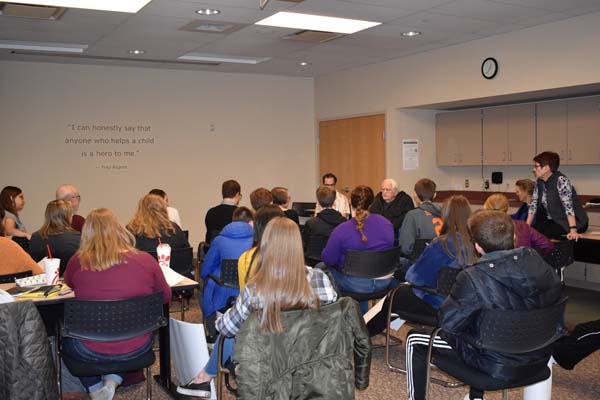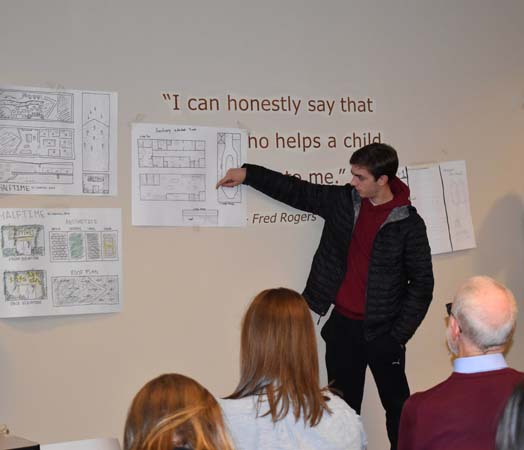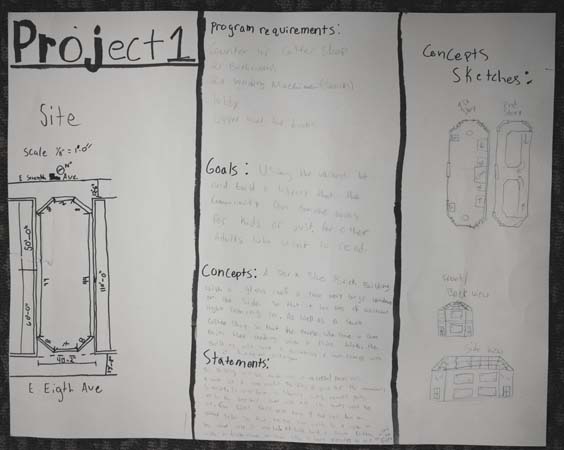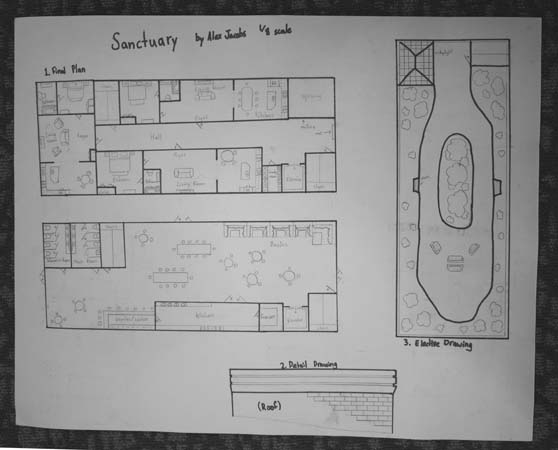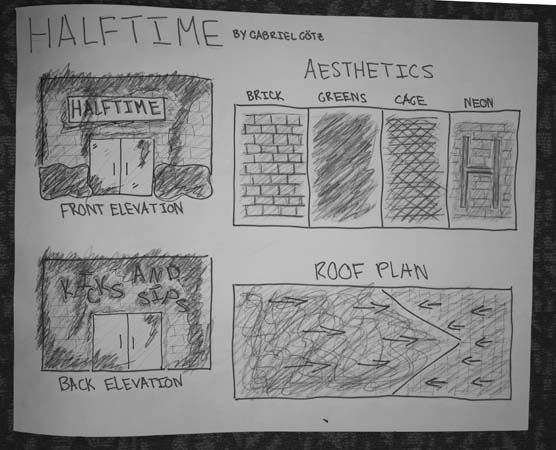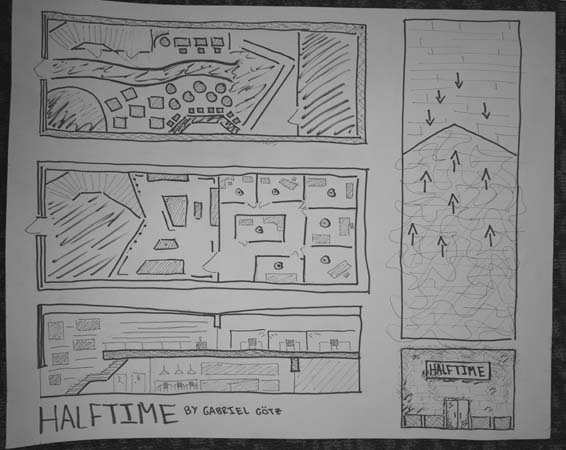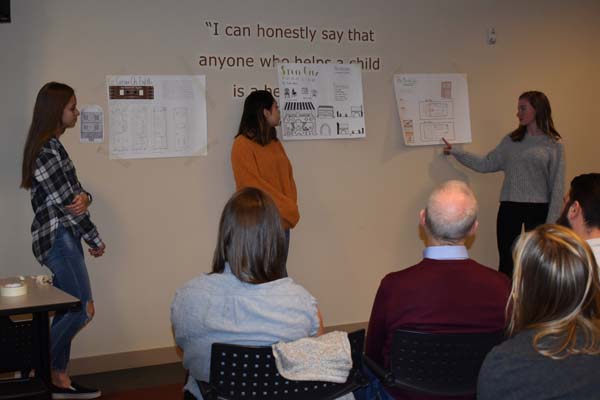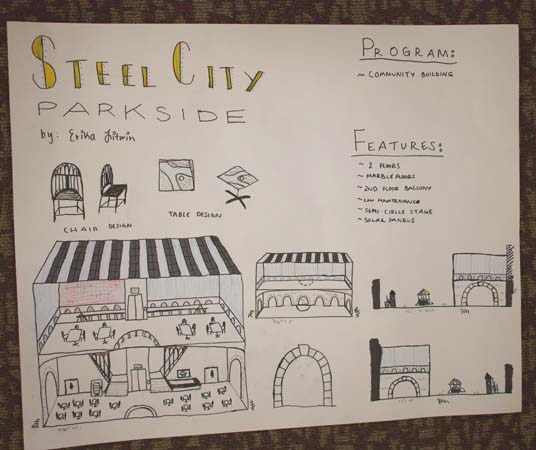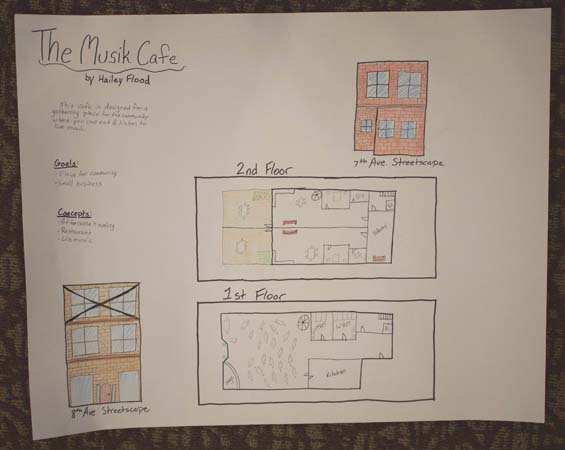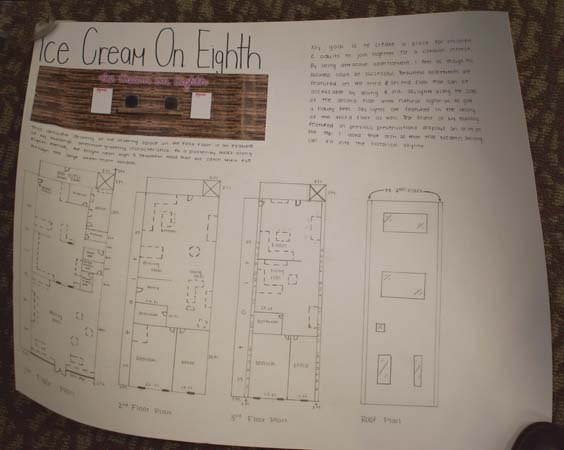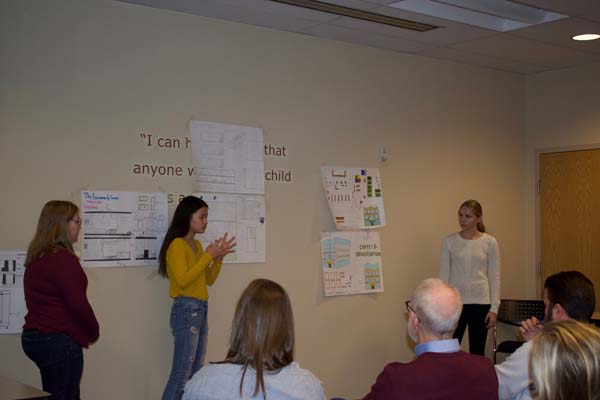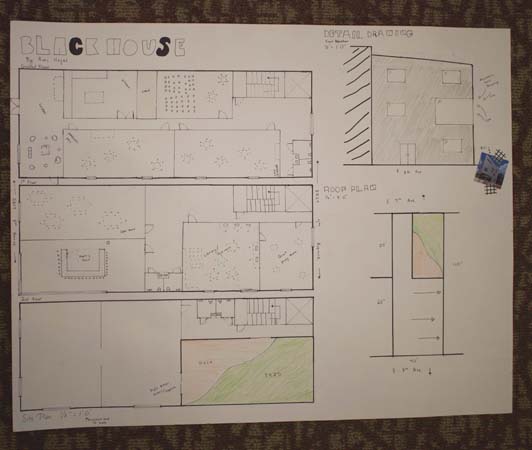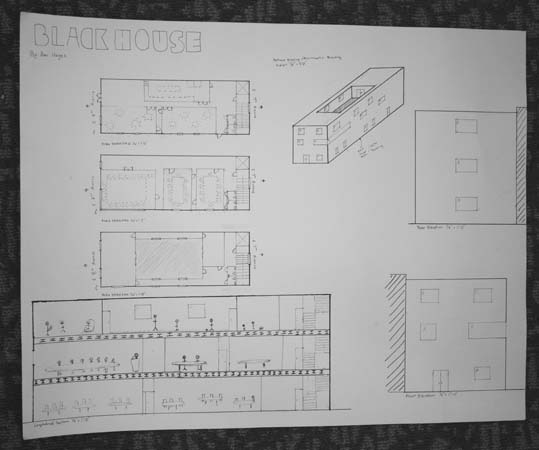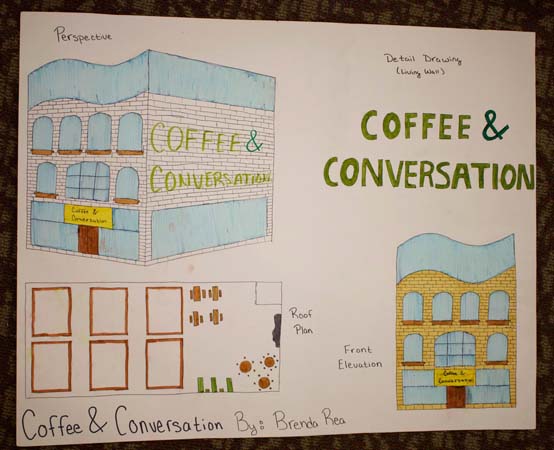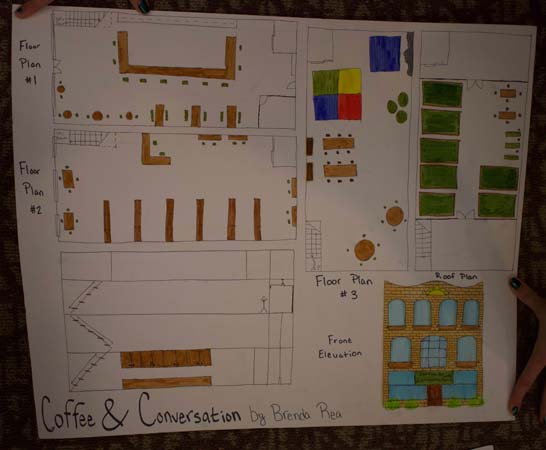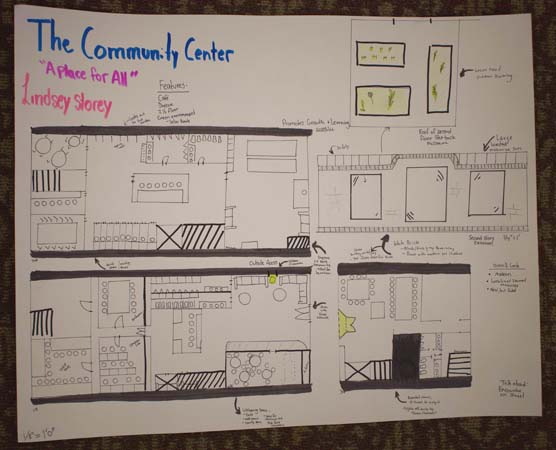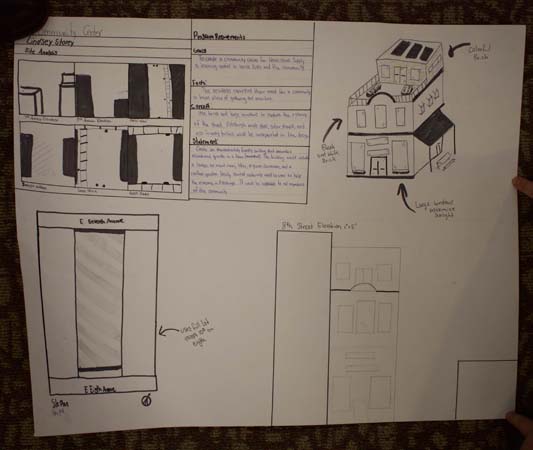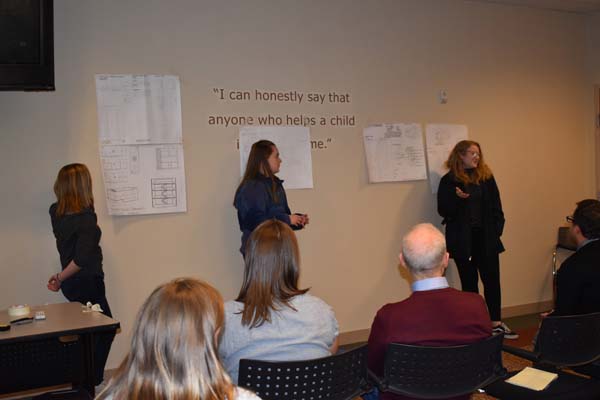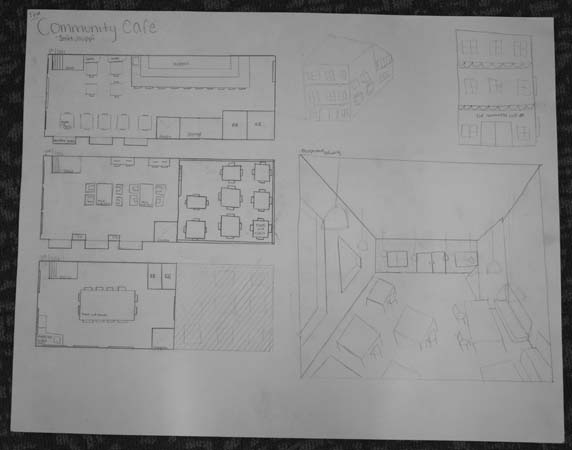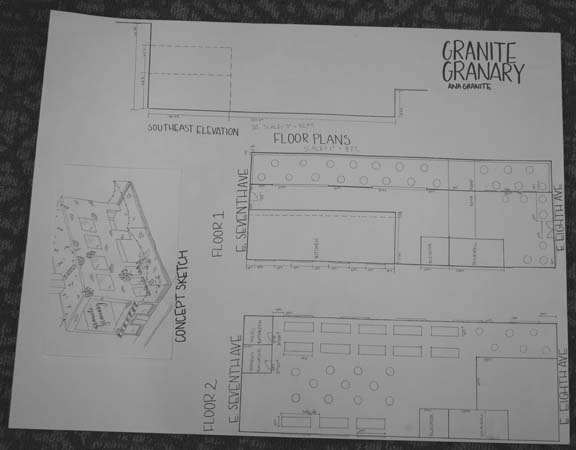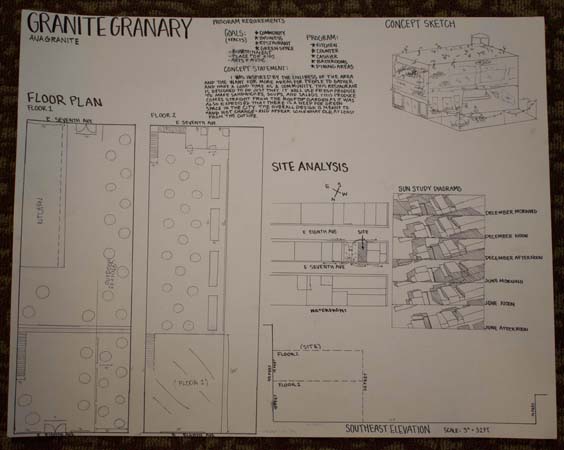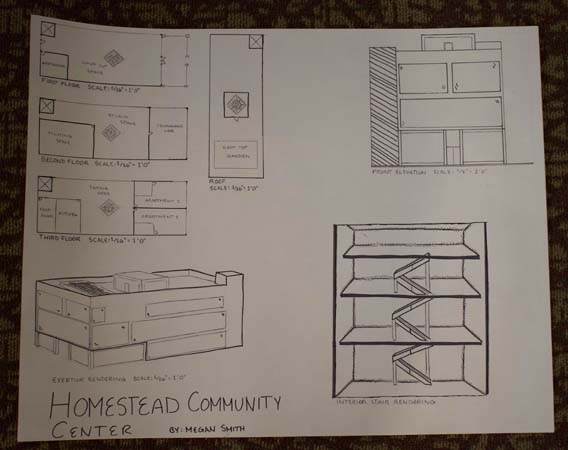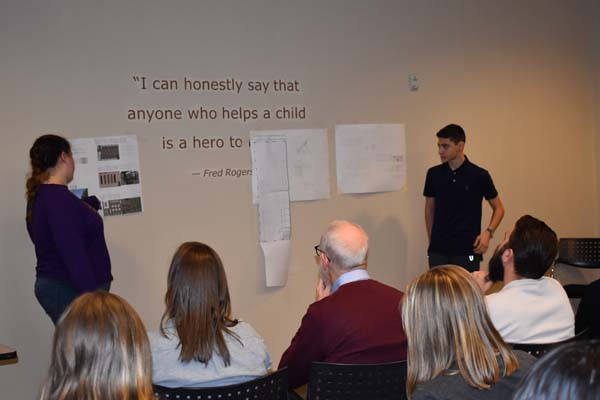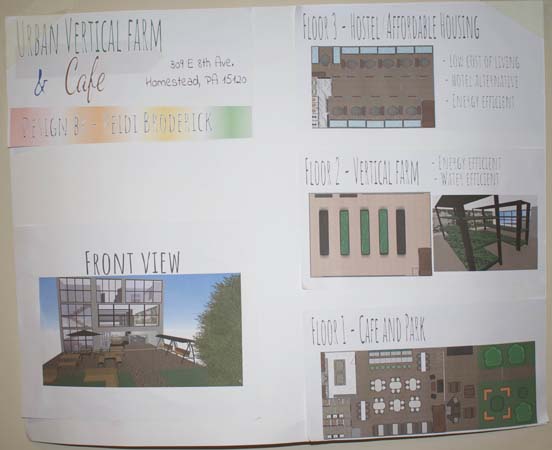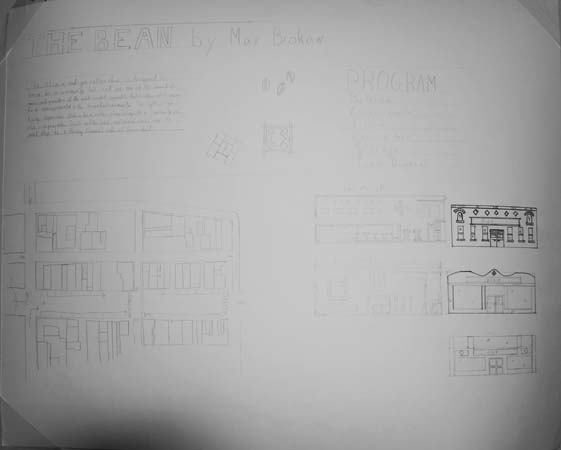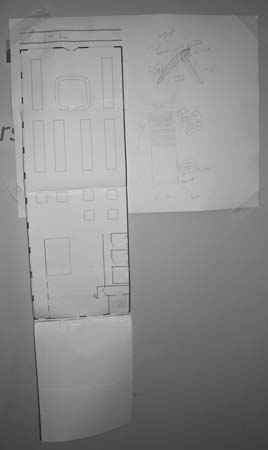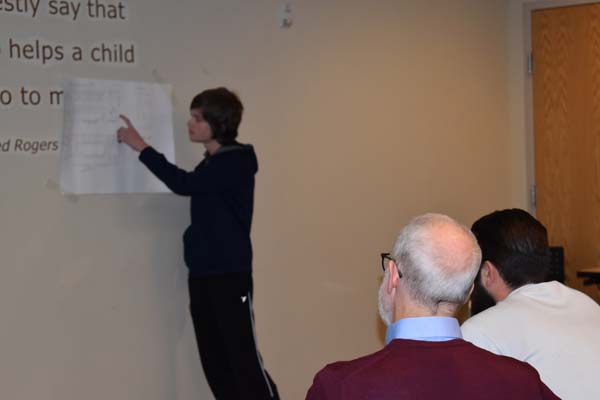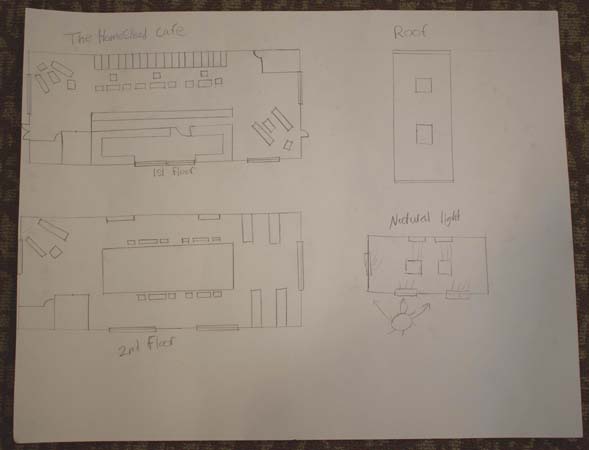
Latest News
-
PHLF’s Winter Interns “Look Up” to See Their City
Over the years, PHLF has been fortunate to have many volunteer interns. This winter, we welcomed two more: Margaux Wilson, from the Indiana University of Pennsylvania, who finished her internship in January; and Karlena Calabro, also from IUP, who will be helping out at PHLF until early spring.
Over my winter break I decided to apply for a volunteer internship at Pittsburgh History & Landmarks Foundation. Among the many activities I helped out with during my internship, I participated in a staff walking tour of Downtown Pittsburgh in late December. During this tour, I realized that by not “looking up” I was missing out on the beauty of Pittsburgh. When I looked up at the different buildings, I finally got to see the amazing details of places I thought I was familiar with! For example, in Market Square, I never realized how intricate and decorative the human-scale buildings are, even though I have been in Market Square before. Along Fourth Avenue’s Historic District, I never stopped to look up before; if I had, I would have seen the small details that make the buildings feel so impressive!
At first, I was nervous that I would not find anything interesting during my walk, but I was wrong. This tour allowed me to see a different side of my city and explore it from a new perspective. Now when I walk around Pittsburgh––or any other city––I start looking up at the buildings and admiring the architecture.
–Margaux Wilson, IUP, majoring in Art history (minoring in Asian Studies).
Interning with PHLF has been an insightful and exciting experience. I was given the chance to examine artifacts from Pittsburgh’s past and help set up educational tours/programs for Pittsburgh students. I have worked in archival studies and even examined hand written letters from 1863!
At PHLF, the history of Pittsburgh comes alive and is totally accessible. It makes me feel more in touch and knowledgeable about the city and people around me. I am very happy with my internship so far.
– Karlena Calabro, IUP, majoring in Anthropology (concentrating in archaeology).
Below is a gallery of photographs taken by our winter intern Margaux Wilson during her walking tour of Downtown Pittsburgh.
-
Landmarks Scholarship Opportunity for Allegheny County Students
For the twenty-second year, thanks to funding support from PHLF’s Brashear Family Donor Advised Fund, the McSwigan Family Foundation Fund of The Pittsburgh Foundation, Dollar Bank Foundation, and others, PHLF is offering a scholarship program for high-achieving, community-minded, high-school seniors in Allegheny County who will be attending college or university in the fall of 2020. “The students selected by our committee already feel connected to the city and its history and will hopefully continue to serve the region as leaders in promoting PHLF’s values,” said David Brashear, a PHLF trustee and the program founder.
“I know now that […] I will be able to achieve my dream of becoming an architect and one day, hope to allow my creations to be a new part of history in my hometown of Pittsburgh.” This essay from a Landmarks Scholarship recipient in 1999 demonstrates the powerful impact our scholarship program can have. Each applicant is asked to describe in an essay a place in Allegheny County that is especially important to him/her; these essays show how our scholarship has helped future preservationists, architects, designers, and planners actualize their career dreams and remain connected to the Pittsburgh region.
If you would like to donate to our Landmarks Scholarship Program to help it grow and to ensure that it continues, please click here or contact Mary Lu Denny at PHLF. Thank you!
Since 1999, PHLF has awarded scholarships to 76 high school seniors who care deeply about the Pittsburgh region. The scholarship award of $6,000, payable over four years to the recipient’s college or university, is for book and tuition expenses only. In addition, PHLF has awarded Honorable Mentions (a one-time gift of $250) to 14 students since 2016. Thirty-five of these 90 recipients attended Pittsburgh Public High Schools and 55 attended other schools within Allegheny County. The application deadline is April 21, 2020. Download an application HERE or click here to learn more about the eligibility requirements and criteria.
-
PHLF’s “Building Pride, Building Character” Program Poetry & Art Begins
This February, our fourteenth year of place-based education programs with twelve Pittsburgh Public Schools continues, with four Pittsburgh Public Schools participating in PHLF’s Poetry & Art tour on the campus of Carnegie Mellon University. We will also share our Portable Pittsburgh Artifact Kit with PPS Roosevelt and Dilworth students.
PHLF is able to offer these field trips and in-school activities for the Pittsburgh Public Schools through the Pennsylvania Department of Community and Economic Development’s Educational Improvement Tax Credit (EITC) program. This year, Dollar Bank donated $5,000 to support this program, in addition to corporate sponsors from 2019:
- First National Bank of Pennsylvania,
- Frank B. Fuhrer Wholesale Company,
- Hefren-Tillotson, Inc.,
- Maher Duessel, CPA,
- PNC Bank,
- The Buncher Company, and
This program also receives foundation support from:
- The Eat’n Park Hospitality Group Fund of The Pittsburgh Foundation, and
- The McSwigan Family Foundation Fund of The Pittsburgh Foundation.
The students involved in “Building Pride, Building Character” tours and enrichment activities have a chance to know their city better, and through knowing, to care about it more.
During Poetry & Art, students tour CMU’s campus, drawing inspiration from architectural details and using them to jumpstart their own creative work. After exploring the campus, students create original poetry compositions as well as charcoal artwork.
Portable Pittsburgh––an in-school presentation––shares Pittsburgh’s rich past through REAL artifacts! Over thirty mystery artifacts are given to students for them to guess their use and place in time. After examining each artifact, students discover Pittsburgh’s history as told through each artifact. Pre-historic tools, minerals such as coal and limestone, 20th century children’s clothing, and Heinz ketchup bottles all combine to bring Pittsburgh’s architecture and history to life.
To view highlighted pictures from past EITC program years, click HERE.
These successful programs are always in need of corporate support! To contribute to PHLF’s “Building Pride, Building Character” (BPBC) EITC program, please click HERE.
-
Donor Advised Funds Help Fund Mission-Related Work
Dear friends,
I would like to report to you about our Donor Advised Funds, which help to underwrite important programs at Pittsburgh History & Landmarks Foundation. We have 26 such funds that have helped fund our programs in historic building restoration, education, and advocacy.
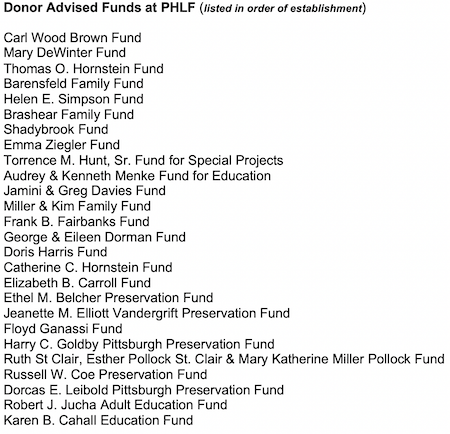 Donor Advised Funds are permanently endowed funds. Once established, they can grow through continuing contributions by the donor who created them or by other donors who may wish to help grow a particular fund. Each year we distribute approximately 4% to 5% of the value of each fund on a rolling three-year average to the preservation work a donor wishes, or to the purposes for which the fund was established.
Donor Advised Funds are permanently endowed funds. Once established, they can grow through continuing contributions by the donor who created them or by other donors who may wish to help grow a particular fund. Each year we distribute approximately 4% to 5% of the value of each fund on a rolling three-year average to the preservation work a donor wishes, or to the purposes for which the fund was established.I have personally established two such funds, which continue to grow through contributions from friends and family members as well as the investment return generated by the Landmarks Financial Corporation, our investment subsidiary.
Thanks to our Donor Advised Funds, we have been able to acquire and restore very deteriorated houses in historic neighborhoods. We recently completed restoration of two such houses at 1403 and 1405 Pennsylvania Avenue in Manchester, which we have put on the market on a subsidized basis to help maintain affordability in a highly appreciating real estate market. Our Donor Advised Funds also help fund our educational programs, our Historic Religious Properties Grant program, and our Frank B. Fairbanks Rail Transportation Archive.
Other organizations that received funding assistance from PHLF’s Donor Advised Funds include: the Trust for Public Land, the National Association for Olmsted Parks, Project for Public Spaces, Duquesne Heights Incline, Dormont Historical Society, The Cultural Landscape Foundation, Western Pennsylvania School for the Deaf, Phipps Conservatory and Botanical Gardens, Rotary Club of Monroeville, the Western Pennsylvania Conservancy, the National Trust for Historic Preservation, Frick Art & Historical Center, Andrew Carnegie Free Library, Children’s Museum of Pittsburgh, the Homeless Children’s Education Fund, Allegheny City Society, Rosewood Block Cluster, and the Trolley Museum, among others.
Arthur Ziegler
President -
Look Up! You Never Know What You Might be Missing!
By Tracy Myers
Co-Director, Education
Pittsburgh History & Landmarks FoundationIf you have ever taken one of the many walking tours PHLF offers from April through October every year, you know that one of our rallying cries is “Look Up!” Tour leaders encourage participants to lift their eyes from what is immediately within sight to the rich and often surprising detail to be found in Pittsburgh’s historic architecture. We even have T-shirts with the exhortation to “Look Up” on the back, as a reminder to tour participants—and to ourselves, perhaps—that this is the best way to “get” our city’s built environment.
Although I relocated to Pittsburgh more than 20 years ago specifically for its marvelous buildings and topography, it is only since becoming co-director of education at PHLF last August that I have come to appreciate the true wealth of the city’s architecture. And that is because, in the course of becoming familiar with our tours, I really started to… look up. In doing so Downtown, I have been delighted to discover the abundance of architectural detail. Look up, and you’re liable to see a winged grotesque, or an Atlas-like figure holding up the cornice that caps a building, or a lace-like aluminum church steeple, or the ghost of a building that has been torn down. You might see luscious blue terra cotta decoration on a building façade protected by a PHLF easement, or a procession of lion heads holding the line against a corporate cathedral. You could even espy a sculpture of an engineer tucked against a beam of a bridge, hiding in plain sight.
I also have been reminded of the amazing variety of architectural vistas that Downtown’s unusual geography and urban plan offer up. I am constantly surprised that the same group of buildings can give different impressions depending on the street from which they’re viewed. Turn a corner, and you might think, “Wait—is that the same building that I saw just a minute ago?”—a satisfying kind of disorientation that you can experience only by looking up. Expand your field of vision even further, and you cannot help but be taken by the stunning natural backdrop of Mount Washington, the rivers, and the hills.
Downtown Pittsburgh’s architecture is a brilliant microcosm of dominant trends throughout America over the last 200 years. What makes our architectural heritage unique is the fullness and vibrancy of its expression. The photographs in the gallery below, most of which were taken by Sarah Greenwald, my fellow co-director of education, offer just a glimpse of the architectural treasures you might encounter on one of our tours. The education department staff and our corps of 50 docents are busily working on the schedule of tours for 2020. We look forward to sharing Pittsburgh’s architecture with learners of all ages. In the meantime, PHLF members will enjoy reading an article by Charles Rosenblum about touring with PHLF that will be published in our annual 24-page PHLF News, due out by February 2020.
-
Architecture Apprentices Present Final Designs for Homestead Vacant Lot
High school students from all over Allegheny County finished their fifth and final session on December 13, 2019, in PHLF’s Architecture Apprenticeship program sponsored by the Allegheny Intermediate Unit. After learning about Pittsburgh’s industrial legacy through a guided tour of Rivers of Steel’s Pump House, Carrie Furnaces, and Bost Building, sixteen students presented their final designs for a vacant lot in Homestead. A panel of professionals––Nicole Kubas (CitySTUDIO), Jenna Kappelt (ALN Manager), Patrick Russell (R3A Architects), Paul Tellers (architect), Daniel Valentine (local developer), Dave Yargeau (Mon Valley Initiative), and David Lewis (distinguished urban designer and one of PHLF’s founding trustees)––listened to the student’s innovative ideas and provided their own constructive comments.
The basis of the students’ hands-on, inquiry-based learning was a vacant lot on Homestead’s 8th Avenue. Through a site analysis, visits with professionals in architecture and related fields, as well as tours of historic buildings and sustainable initiatives on CMU’s campus and in downtown Pittsburgh, students were introduced to careers in architecture, urban planning, and historic preservation.
This course gave students the opportunity to experience first-hand—and often for the first time—the joys and challenges of pursuing these careers. Speaking of his design process, one student remarked to judges, “I know what it looks like in my head. It’s harder to get on paper.” David Lewis, one of the panelists, encouraged students by explaining that “exploring an idea is what you are doing in architecture.” The following designs (see photo gallery) were among the proposals for the vacant lot:
- a public donation library and snack shop;
- a restaurant and upper-level apartments (“Sanctuary”);
- an athletic store and live music café (“Halftime”),
- a Pittsburgh-themed community hangout space (“Steel City Parkside”);
- affordable housing units with a lower-level cabaret space;
- an ice cream shop with upper-level apartments;
- a combination café, daycare, and urban garden;
- a community center with lounges, classrooms, and event spaces;
- a vertical farm; and,
- a community arcade and recreational center.
“So many of these projects open the doors to the community. All of them are quite wonderful – that is what we want in our communities,” observed David Lewis. Many of the proposals included thoughtful incorporations of mixed-use concepts, sustainable design and community-service-oriented concepts. When asked to describe their Architecture Apprenticeship experience, students wrote:
- This apprenticeship really helped me to become more confident in my designs and being able to express them better as well.
- I used this apprenticeship to help me determine if architecture would be a good career path for me.
- It made me realize just how much thought and planning goes into designing a space for a community.
- This program helped me be aware of architecture all around me. I learned how to be a better city planner and realized how to imagine a practical building.
- It helped me appreciate the design and functions of buildings, and it helped me understand the duties of an architect.
Students were also asked to describe their experiences in five words or phrases. Responses included:
- Fulfilling; fun; knowledgeable; unique; beneficial.
- Educational; helpful; created opportunities; fun; eye-opening.
- Insightful; true-world experience; hands-on; historical; informational yet enjoyable.
- Eye-opening; historic; learning how to repurpose new to old and old to new; preserve—an art form, I believe, keeping old things relevant; character—most important, every building has this.
- Interesting; I liked the history; I liked the different styles of buildings; I liked hearing about peoples’ stories of how they got to where they are; helpful.
- Fun; challenging; cool; I was able to see lots of our city.
After all the students presented, David Lewis impressed upon them that “architecture stands on the threshold of the past and future. Architecture is what we inherit and where we are going. Westand always on that threshold.”
To the McSwigan Family Foundation Fund of The Pittsburgh Foundation, whose funding supports this program, and to all of the professionals who spent time with these high school students, we thank you!
-
Book Celebration: Alan I W Frank House: The Modernist Masterwork by Walter Gropius and Marcel Breuer
“A Conversation about the Frank House: Raymund Ryan, Curator of Architecture, Carnegie Museum of Art, with Alan Frank”
Saturday, December 7, 2019
1:30 p.m. to 2:30 p.m.
Carnegie Museum of Art
4400 Forbes Avenue
Pittsburgh, PA 15213Admission to the event is free
PHLF is pleased to join Carnegie Museum of Art in presenting a conversation and book signing to celebrate the release of Alan I W Frank House: The Modernist Masterwork by Walter Gropius and Marcel Breuer. The Frank House was constructed in 1939-40 on East Woodland Road in Shadyside and is the largest residence designed by Gropius and Breuer, two of the most influential architect/designers in America in the 20th century. The book’s release coincides with the 100th anniversary of the Bauhaus, a German art school founded by Walter Gropius in 1919. We congratulate Mr. Frank on its release.
Our members and friends are invited to attend the special event and book signing on Saturday, December 7, at 1:30 p.m. in the Carnegie Museum of Art Theater. Reservations are not needed. Following his conversation with Mr. Ryan, Mr. Frank will autograph copies of the book ($65.00). Published by Rizzoli, the 256-page book includes critical essays by Kenneth Frampton, Barry Bergdoll, and Charles A. Birnbaum––prominent architecture and landscape historians––and is lavishly illustrated with new photographs by Richard Barnes and Richard Pare.
Recognized as one of Pittsburgh’s most important works of mid-20th-century architecture, the Frank House is also featured in Albert M. Tannler’s Pittsburgh Architecture in the Twentieth Century: Notable Modern Buildings and Their Architects, published by PHLF in 2013.
In 2016, PHLF awarded a $10,000 grant from its Walter C. Kidney Library and Publications Fund to the Alan I W Frank House Foundation to help fund the book, Alan I W Frank House: The Modernist Masterwork by Walter Gropius and Marcel Breuer.
-
Visiting Kelly Art Glass in Millvale
By Laurie Cohen, PHLF member
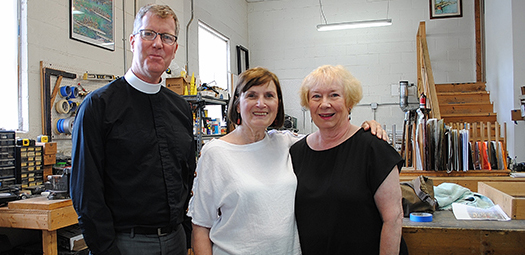
Church of the Redeemer members from left: Reverend Michael Foley; Karen Esch, chair of the Windows Fund Campaign; and Patricia Edgar, Chair of the church’s restoration committee. Photo by Laurie Cohen.
On Sunday, September 15th, twenty-three members of Church of the Redeemer in Squirrel Hill visited Kelly Art Glass in Millvale. The church is one of the recipients this year of a matching grant from PHLF’s Historic Religious Properties Program. As a result, Kelly Art Glass is restoring four stained-glass windows from Redeemer, including the replacement of plexiglass with vented storm windows.
John Kelly, founder of Kelly Art Glass, and two of his assistants greeted everyone and explained why older windows sometimes need to be restored. In the U.S., it was generally thought that lead had a lifespan of 80 to 100 years, but when glass historians visited French cathedrals and churches, they noticed that the windows were still in place after more than 400 years. The reason is that the French added 2% of antimony to the lead, a practice that was incorporated in U.S. lead production beginning in the 1960s.
In preparing to restore art-glass windows, John always looks into the work and history of the original artist. Redeemer windows were created by Howard Gilman Wilbert between 1939 and 1962. Wilbert was the founder of Pittsburgh Stained Glass Studio, the foremost glass painters of their day. He was known for his complicated and beautiful designs. Church of the Redeemer is the only church in the United States where Wilbert designed all the windows.
For many years, it was common for churches to use plastic storm windows to protect them from the elements or from damage. Unfortunately, the air pocket created between the storm window and stained glass would cause heat to build up, which then would cause the relatively soft lead to buckle. When lead buckles, it takes the window with it, so the window requires “re-lead restoration.” Using a flexible, silicone caulk allows movement of the material, and replacing the plastic with vented-glass storm windows allows the air to circulate. The restoration increases air circulation, pressure equalization, and ultimately, the longevity of the windows.
John described the process of removing the Church of the Redeemer windows for repair. It was a delicate task because of their condition. The team built a wooden shipping-container-like structure, containing Styrofoam and bubble wrap, to protect the transfer from the Squirrel Hill church to the Millvale studio. No scaffolding was used, which church members appreciated.
During the restoration, glass worker Pete Boucher discovered an unusual practice. Pieces of glass were hidden behind the lead with the words “by Mr. and Mrs. John Sherriff” etched onto the window. It is rare to find donors’ names incorporated into the glass.
The narthex screen had buckled, so brass strips were added through the glass to strengthen the window. In some cases, glass was added to increase the visibility of the scenes depicted. In places where glass was broken, the color had to be matched and painted over.
John and his assistants walked the visitors through the process of glass and lead restoration. First, a template of the window is created by laying a piece of paper over the window and chalking out the outline to create a rubbing. The individual pieces of glass are then laid to soak in a tray of non-detergent solvent for several days, in order to dissolve concrete or any other substance, and are scrubbed. The clean pieces are then placed over the rubbing in the places where they will be reattached, and outlines of the pieces are drawn. The outlines of the glass are nailed into the plywood underneath the rubbing to hold them in place. The thicker pieces of glass are used to create shading. Finally, all of the pieces are held together by the lead.
Stained-glass window restoration is a thorough undertaking. It sometimes takes years of research to understand the windows’ history and construction before restoration itself can begin. Kelly Art Glass documents all its work, including recording field notes, before-and-after photos, correspondence regarding the windows, and a detailed description of the restoration process. This ensures that future generations know what work was done, so that if restoration technology changes, the necessary adjustments in the work can be made.
Church of the Redeemer members were enthusiastic during the tour and thanked PHLF for the opportunity to have their windows restored. Their enthusiasm was matched by John’s passion for his work and his delight in sharing some of his knowledge with the parishioners. He said that windows like these are an extremely personal investment, but they bring joy to parishioners and the public for generations.

